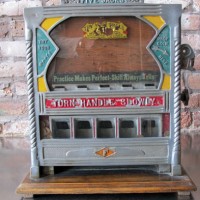Voices
What's My Stuff Worth: Game Machine, Brass Canaries
- Details
- Published on Tuesday, 01 November 2011 14:56
- Written by Paul Gordon
With Dan Philips
It is common today to find different types of small machines just inside the entry vestibules at grocery stores or pharmacies, machines that give out gum balls or little trinkets, usually for a quarter or two. Some are gaming machines in which you try your skills at nabbing something of value with a crane. They've been around for years.
They also have evolved through the years, first becoming popular in the early part of the 20th century when small gaming machines — known as "trade stimulators" —would take pennies and give out an item in the slot where the penny landed.
The idea was to attract and keep customers in the grocery, drugstore or even bars where the machines could be found.
Some trade stimulators were made in Peoria and a few are still around, such as the one owned by Julie Russell, owner of AdCo Advertising Agency who comes from a family of collectors of antiques, including toys. She has a trade stimulator manufactured around 1890 by Field Manufacturing Corp. of Peoria.
The machine, with a dovetailed oak case in a die cast frame, still has its original operating parts, including the wheel on the side the person turned to see if their coin landed in a slot that contained a prize of some sort.
The machine remains in good condition for something more than a century old, said Dan Philips, antique expert and former owner of Illinois Antique Center. Even the Field Manufacturing label on the side of the machine is the original.
Philips explained that trade stimulators reached their peak of popularity after World War I, when disposable income was scarce and people could win something for as little as a penny. Most were destroyed during prohibition along with other gaming devices and few remain today.
Philips estimated the trade stimulator would sell for $1,100 to $1,500 and would be considered a "cross-collectible" in that it could sell in different categories, including gaming devices or even in Peoria history.
Another set of toys Russell asked Philips to assess was a pair of canaries. These were not the feathered kind; rather, these are made of brass. But with a bit of water and breath control, they can be made to sound like the real deal.
The birds in this instance are called Victory Canary Songsters. The small brass birds are attached to a small vessel in which water is stored, then a person blows into a rubber tube to cause the toy to chirp like a canary.
Also known as "water warblers" and "nightingales" the history of these toys can be traced about 1,000 years, when the Chinese made them out of clay, Philips said. Many were made in England and the Russell collection is from the French variety, Julie Russell said, patented in 1880.
Philips estimated the value of the canary that was still in its box at $35 to $100 and the other at $25 to $35. Both, he said, are still in good shape even thought neither still has its original rubber tube.
Finally, all of us at one time or another have played with mini-pinball games, where the object is to shoot a small ball up a chute and try to get it to land in a certain hole to score points.
The Russell collection includes one called "Happy Tappy" and it was made in Minneapolis by Taplin Toys Incorporated. The object is to take 10 shots to try and get five balls into the eyes, nose and teeth of a clownish face called Happy Tappy. Point values are assigned each space with 100 points per turn being the maximum.
Happy Tappy was made in the 1960s, one of many toys made by the company and the type of toy a person might find in a "dime store" such as a Ben Franklin, Philips said. He estimated this one, still in working order and in a box in good condition, might sell for $10 to $15.
Philips and his wife Kim recently closed the Illinois Antique Center but continue to assess items and to do estate sales. He will evaluate items for The Peorian, if people want to write to him at www.thepeorian.com and give detailed descriptions or send digital photos the item.
Philips said he will likely advise having an appraiser actually see and touch an item, something he is willing to do by appointment.
Got old stuff? It may (or may not) be worth something.
Email editor@ThePeorian.com if you think you have something of worth.


















































